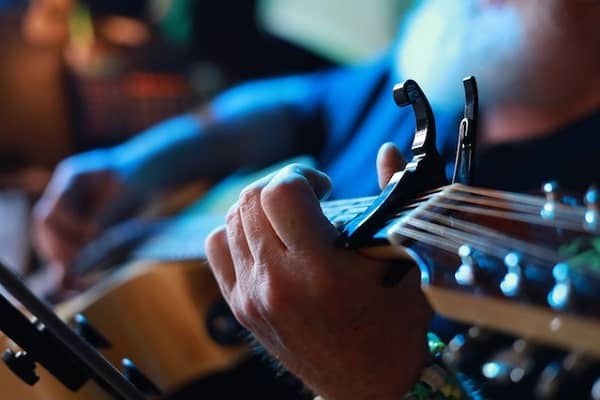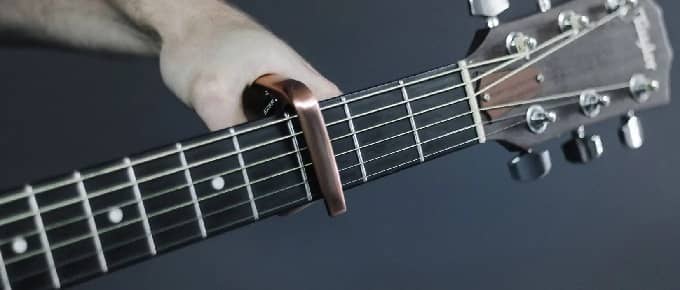Have you ever been jamming with your guitarist buddies and one of them says “Hey, put a capo on the 2nd fret for this next song”? If you gave them a blank stare, you’re not alone.
Capos can be confusing gadgets for a beginner guitarist. Understanding how to use a capo properly allows guitarists to easily transpose songs into new keys that may better suit their vocal range. This simple tool opens up more possibilities for guitar players of all skill levels.
Read on to learn more about the purpose and benefits of the capo, the different types available, and tips for getting the most out of capo use because this knowledge will expand your abilities as a guitarist.
What is a Capo for Guitar?
A capo (or capotasto) is a small clamp that attaches to the neck of a guitar. It functions like a movable nut to shorten the strings and raise the overall pitch of the instrument.
Capo comes from the Italian word for “head”, which makes sense since it provides a new starting point on the neck.
There are a few different types of capos, but they all serve the same purpose:
Clamp Styles

Screw capos use a screw mechanism to tighten the capo onto the guitar neck. Just twist the screw till it’s snug on the strings.
Spring capos utilize a spring-loaded clamp that allows quick on/off action. Just squeeze the handle to release the capo.
Elastic capos have a strap that wraps around the neck and secures with a notch. Less popular but good in a pinch.
Partial Capos
Unlike full capos that cover all strings, partial capos only cover some of the strings. Allows you to create alternate tunings without retuning the whole guitar.
The best capo type depends on your needs. Clamp styles are ideal for frequent capo changes, while elastic straps provide a budget-friendly option. Take into account your playing style and guitar type when choosing a capo.
Now that you know the different kinds of capos, let’s look at the benefits of using a capo.
Benefits of Using a Guitar Capo
There are so many advantages to having a capo in your guitar toolbox. Let’s look at some of the best reasons to start integrating capo techniques into your playing.
Makes Playing Easier for Beginners
One of the biggest benefits of the capo is that it makes learning guitar much easier, especially for beginners. Guitar has a notoriously steep initial learning curve. Those barre chords and cramped fingers quickly lead to soreness and frustration.
But with a capo, you can avoid barres entirely at first. By capoing up just a couple of frets, basic open chords become much easier to play. The neck is tighter, so your fingers don’t have to stretch as much. And you don’t need to press down as hard to fret cleanly.
So while your fretting hand is still building strength and flexibility, the capo gives it a nice little break. You’ll be able to practice more comfortably for longer periods. And the quick wins will help build confidence.
Allows You To Play More Songs With Fewer Chords

Another capo superpower is enabling you to play more of your favorite songs early on, even if you only know a handful of chords.
For example, with just G, C, D, and Em chords under your fingers, you can play songs in the keys of G Major, C Major, D Major, and E Minor.
But then add a capo into the mix, and you can play all of those chord progressions in every other key too. For each fret you go up, you transpose the key up one-half step.
So just knowing basic G, C, D, and Em chord shapes means you can suddenly play literally thousands of songs. Talk about motivation to practice!
This also applies to more advanced players working out new songs by ear. No need to learn the chord shapes in every obscure key – just capo up to where you want to play.
Transposes Keys to Suit Your Vocal Range
Here’s another extremely useful application – changing the key of a song to better suit your singing voice. We’ve all tried to sing along, only to realize the song is in way too high or low of a key for our vocal range.
That’s when the capo becomes your best friend. You can easily tweak the key up or down until you find your “sweet spot” that’s comfortable to sing in. No more straining to hit high notes or croaking out the low ones.
Keep a capo in your gig bag so you can make on-the-fly key adjustments if needed. As a bonus, it leaves your fretting hand free to focus just on chords, not complex barre shapes.
Enables Alternate Chord Voicings and Textures
One cool musical trick is using a capo to get different chord voicings and tonal textures. For example, try playing a G chord with no capo vs. 7th fret capo. It’s still technically a G chord, but it sounds brighter and more sparkly up high on the neck.
This opens up creative possibilities for guitarists. You can invent more interesting chord progressions by moving certain chords up the neck to change their voicing.
And using a partial capo gives even more options. You can create gorgeous harp-like tones by pressing down just 3-4 strings in the middle of the neck. Definitely experiment with capo textures.
Gives Your Fretting Hand a Rest During Practice
Practicing for long periods can lead to a sore fretting hand, especially if you’re drilling barre chords and complex chord changes. This is where the capo comes in handy yet again.
Throwing on a capo allows you to practice open chord songs higher up the neck. This usually requires less stretching and tension than playing open chords down low. So you give your fretting hand a bit of a break, while still practicing important muscle memory.
Any time your fretting hand needs a breather, use your capo and play for a bit in a higher key. You’ll be able to maintain longer, more productive practice sessions this way.
Changes the Tone and Timbre of Your Guitar
In addition to changing the key and pitch, using a capo also alters the overall tone and timbre of your guitar sound. The difference may be subtle, but playing high up on the neck tends to give a brighter, crisper tone.
This can be used to great effect when layering two guitar parts. Try one part low on the neck, the other with a capo up around the 5th-7th fret. Blend the two tones together for more flavor and depth.
Capo Techniques for Various Genres
Certain genres utilize capos more than others as part of their distinctive sound:
Blues Guitar: The shortened scale and modified voicings from capos give blues guitars a signature twangy resonance.
Folk and Bluegrass: Transposing with a capo is integral to folk music’s reliance on open chords. Creates a ringing drone effect.
Flamenco Guitar: The lively tonality of flamenco stems largely from capo usage combined with rhythmic phrasing.
Traditional Irish Music: Capos allow Irish trad players to easily accompany fiddles and tin whistles in D major.
Singer-Songwriter: Capos enable songwriters to modulate keys for vocals without learning new chord voicings.
Rock and Pop: Iconic artists like Springsteen and John Mayer implement capos to add tonal variety.
Now that you know how capos produce different sounds, let’s discuss buying tips…
Tips for Buying a Guitar Capo

With so many models available, keep these factors in mind when choosing a capo:
- Quick attachment/release – Look for fast clamping mechanisms if you’ll be changing capo position frequently.
- Comfortable grip – The capo’s handle should fit your hand size and be easy to squeeze.
- Snug fit – Make sure the capo bars evenly across all strings to avoid muting or buzzing.
- Material quality – Capo bars with protective rubber prevent string damage. Durable build lasts.
- Guitar type – Consider your guitar’s neck width and curve to get an optimal capo fit.
Invest in a quality capo so you can transpose in tune without hassles. It will be a friend for life!
Now let’s go over some common capo mistakes to avoid…
Common Mistakes and Problems with Capos
Proper capo technique takes some practice. Watch out for these common capo slip-ups:
- Applying incorrectly – Make sure capo encircles entire fret to prevent muting or buzzing.
- Not checking tuning – Clamping can slightly detune so always tune up after placing capo.
- String damage – Releasing capo carelessly can pull and wear down strings over time.
- Overreliance – Don’t use a capo as a crutch to avoid learning techniques like barre chords.
With awareness and care, you can avoid these pitfalls and become a capo master!
Sometimes capos aren’t ideal though. Let’s discuss some alternatives…
Alternatives to Guitar Capos
While capos are handy tools, here are some other options for transposing:
- Partial capos – Cover just some strings for altered tunings without retuning guitar.
- Barre chords – Move open chord shapes up the neck and barre for key changes.
- Retuning – Tune guitar up to play open chords in other keys. More time-consuming.
Capos provide quick key changes, but it pays to have other transposing tricks too!
Final Words
We’ve covered a lot of ground on the art of capo usage. To recap:
- A capo shortens string length to raise pitch and change guitar key.
- Various clamp styles allow quick transpose while keeping familiar chord shapes.
- Apply properly behind the fret wire to avoid muting and string damage.
- Use capo chord charts to determine fret placement for key changes.
- Capos bring out brighter tonal qualities in certain genres.
- Buy a quality capo that fits your guitar and playing style.
Hopefully, you now have a solid grasp on what a guitar capo is and how to integrate it into your practice routine. Unlock new possibilities on the fretboard and take your guitar skills up a notch with this handy transposing tool!
About the Author
Team Guitar Top Review Talk about Guitars! We are a group of friends that bonded over their shared love of playing guitar. We all have different backgrounds and experiences with music, but we share a passion for writing about the things that we love.


